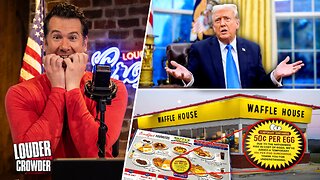Premium Only Content

GMO Tiesday Edition #247 Water...Vax & Chemtrails...
Language warning I got a little animated about the chemtrails....
Twitter Moments@TwitterMoments·Oct 1
COVID-19 vaccines offer better protection than natural immunity gained from prior infection, according to the @CDCgov and fact-checkers.A statement by Bill Gates about vaccines and COVID-19 transmission has been taken out of context, fact-checkers reportMicrosoft co-founder and philanthropist Bill Gates told Britain’s former health secretary Jeremy Hunt in a November 4 interview that although our current vaccines substantially reduce the possibility of contracting a serious case of COVID-19, researchers in the future could focus on improving the vaccines’ ability to prevent transmission of the virus.
Bill Gates ‘Just Plain Wrong’ About Chemical Fertilizers, Scientists SayScientists who authored a report on nitrogen fertilizer said Bill Gates is “just plain wrong” when he says the only way to grow food is with synthetic fertilizers. Their research also suggests the climate impact of nitrogen fertilizers is much worse than previously estimated.https://childrenshealthdefense.org/defender/bill-gates-chemical-fertilizers-global-warming/The FAO’s food price index, which measures world food commodity prices, surged 31.3 percent in the 12 months through October, coming in at a reading of 133.2 points, a level not seen since July 2011.On a month-over-month basis, the index rose by 3.9 points, or 3.0 percent, with the October rise representing the third consecutive month of increases.Accounting for the bulk of the rise in the index were higher prices of most cereals and vegetable oils.The FAO vegetable oil price index hit an all-time high of 184.8 points in October, up 16.3 points, or 9.6 percent compared to September’s reading.“The increase was driven by firmer price quotations for palm, soy, sunflower, and rapeseed oils,” FAO said in a statement, in which it also noted that rising crude oil prices were also a factor.The agency’s cereal price measure rose to 137.1 points in October, up 4.3 points, or 3.2 percent, from September and vaulting to its highest level since November 2012.“Tighter availability in global markets due to reduced harvests in major exporters, especially Canada, the Russian Federation, and the United States of America, continued to put upward pressure on prices,” according to FAO. A combine harvests wheat in Corn, Okla., on June 12, 2019. (Nick Oxford/Reuters)Dairy prices also rose by 2.2 percent month-over-month in October, while the meat price index edged down 0.7 percent and sugar prices fell 1.8 percent.“International price quotations for butter, skim milk powder, and whole milk powder rose steeply for the second consecutive month, underpinned by firm global import demand amid buyers’ efforts to secure supplies to build stocks,” FAO said.Helping to drive down meat prices were drops in international quotations for pig meat, mostly due to reduced buying from China.“By contrast, poultry meat quotations rose, boosted by high global demand, while production expansions remained weak due to high feed costs and avian flu outbreaks, especially in Europe,” FAO said. Ducks are pictured in a field at a poultry farm in Montsoue, France, on Jan.12, 2017. (Regis Duvignau/Reuters)Meanwhile, Butterball CEO Jay Jandrain told Fox News in a recent interview that it’s likely American families will see more expensive Thanksgiving turkeys this year and that smaller ones will be harder to find as inflation remains stubbornly high and the supply chain snarl continues.Jandrain told the outlet on Nov. 2 that, while he doesn’t expect overall shortages of turkeys, “we do see there will be fewer small turkeys this year,” and advised shoppers to “go out to the stores and get them as early as you can.”At the same time, Jandrain said retailers have been ordering more turkeys in the face of increased demand and it’s “reasonable to expect” higher prices.While much of the broader inflation story has focused on surging energy costs and products affected by the semiconductor chip shortage, such as used cars, rising food cost signals have also increasingly flashed red.The Labor Department’s most recent consumer price inflation report showed that meat, poultry, fish, and eggs were up 8 percent over the year in August, and up 15.7 percent from prices in August 2019, before the pandemic. Beef prices jumped 12.2 percent over the past year, and bacon was up 17 percent.Food price inflation has also contributed to a run-up in U.S. consumer expectations for future price increases. The most recent Federal Reserve Bank of New York monthly Survey of Consumer Expectations showed that U.S. households anticipate inflation to be 5.3 percent next year and 4.2 percent in three years, the highest readings in the history of the series, which dates back to 2013.
Fair Use Notice:
Use the information found in the videos as a starting point for conducting your own research and conduct your own due diligence before making any significant investing decisions.
Under the following terms", Attribution-NonCommercial-ShareAlike 4.0 International.
https://creativecommons.org/licenses/by-nc-sa/4.0/
https://creativecommons.org/licenses/by-nc-sa/4.0/legalcode
As with all Independent Journalist folks we can use a helping hand. If you can make a contribution to assist in keeping the lights on please go to my website and use the donate feature in the right sidebar. Thank you
https://paypal.me/aaronaveiro1?locale.x=en_US
-
 58:16
58:16
The Dan Bongino Show
3 hours agoShake-Up In The White House Press Room (Ep. 2431) - 02/26/2025
638K810 -
 1:00:00
1:00:00
The Rubin Report
2 hours agoDem Looks Visibly Angry as Stephen A. Smith Points Out Failures to His Face
40.1K21 -
 LIVE
LIVE
Benny Johnson
2 hours ago🚨 Trump's First White House Cabinet Meeting LIVE Right Now | Massive News Breaking
11,578 watching -
 2:05:04
2:05:04
Steven Crowder
4 hours agoTrump Keeps Delivering | This Week’s 3 Big Wins Explained
379K174 -
 LIVE
LIVE
Flyover Conservatives
2 hours agoProphecies | Breakthrough, Zelensky and 2040 - The Prophetic Report with Stacy Whited
937 watching -

LFA TV
17 hours agoFLUSHING THE TURDS! | LIVE FROM AMERICA 2.26.25 11AM
34.6K10 -
 1:07:54
1:07:54
Timcast
3 hours agoTulsi FIRED 100+ Deep State PERVS After Fed Kink Chat EXPOSED, Trump CLEANS HOUSE | Timcast LIVE
152K41 -
 LIVE
LIVE
Bannons War Room
8 days agoWarRoom Live
7,526 watching -
 2:34:24
2:34:24
House Committee on Energy and Commerce
5 days agoO&I Hearing: Examining the Biden Administration’s Energy and Environment Spending Push
21.4K -
 2:10:18
2:10:18
Matt Kohrs
14 hours agoThe Crypto Crash, Stock Bounce & Breaking News || The MK Show
54.7K3